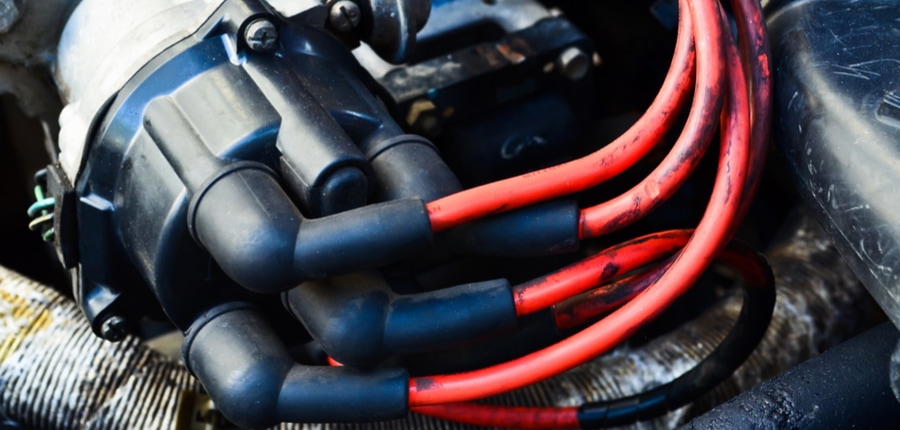For an engine to run the spark plugs must fire, each at exactly the right moment and reliably. On older engine designs the distributor was an important component in that, taking the high voltage output of a single coil and distributing it to the spark plugs according to the firing order.
Two parts of the distributor that wear are the cap and rotor. The rotor is turned by an engine gear or mechanism, and it sends current from the coil out to contacts built into the cap as it rotates. That high voltage current then runs through the ignition wires to the spark plugs. Each time the rotor passes a contact, a spark jumps across that gap, and each spark creates a little bit of wear and carbon.
The cap and rotor wear with use and eventually become unreliable, so they have a scheduled replacement interval, usually each 30,000 miles on older-style engines, and every 50,000 miles on more current designs.
Replacement is pretty straightforward. The cap is held down by bolts or spring holders to the distributor. Once that’s removed, the rotor is right there and usually just slides off the top of the distributor shaft. It is usually preferred to get the cap and rotor as a matched set, or at least for them to be the same manufacturer.
Most modern vehicles don’t use a cap and rotor; instead the crankshaft position is tracked by sensors which inform a PCM, which then fires individual coils that sit directly on each spark plug. This eliminates a lot of the complexity and compromises that older mechanical systems had, and also allows a great deal of flexibility in spark control and timing.
Costs of Distributor Cap and Rotor Replacement
On average, it costs about $120 to replace a cap and rotor of a distributor.
For some specific rotor and cap replacement cost estimates on common vehicles, using $80 as an average labor charge:
For a 1998 Honda Civic with a 1.6 liter engine, a factory cap and rotor costs about $70, and a WVE cap and rotor set costs about $15. With labor, that makes the job about $150 using OE parts, or about $95 using aftermarket parts.
For a 2000 Chevrolet S10 pickup with a 4.3 liter engine, a factory cap and rotor costs about $80, and a United cap and rotor costs about $23. With labor that makes the job about $160 using OE parts, or about $103 using aftermarket parts.
Ford a 1997 Jeep Wrangler with a 4.0 liter engine, a factory cap and rotor costs about $55, and a Standard set costs about $17. With labor that makes the job about $125 using factory parts, or about $97 using aftermarket parts.
These are all using a rough guess of $80 as a labor charge for the cap and rotor replacement. One issue is that the cap and rotor are almost always bundled in with other things rather than replaced by themselves, and another issue is that book time is rarely used on this kind of service. In any case, the cap and rotor are usually accessible and not hard to replace.
What Else Might Need Serviced
On vehicles that used a cap and rotor, it was common to have a 30,000 miles service interval which also included spark plugs and various cleaning and adjustment recommendations – usually called a “tune-up”. On many newer designs with electronic ignition but still using a cap and rotor, the service interval was 50,000, and much less is involved in a tune-up. As with most services, it’s best to be aware of and stick to the owner’s manual recommendations, and usually most economical to do all the tune-up related items at the same time.
Spark plugs are usually the main item, and one that can also be improved on. Older style spark plugs needed replaced more often, but one easy modern improvement is to replace them with long-wearing platinum or iridium plugs. Which can then be changed on their own schedule, though other scheduled service would be unaffected.
Spark plug wires are also frequently replaced. They aren’t usually included in the scheduled service as a maintenance item, but they can become fragile with age and easily damaged when disconnected from the spark plugs at one end or the distributor cap at the other. For that reason they are often included in a tune up or quoted when replacing a cap and rotor; the common problem being (from a mechanic’s perspective) that a vehicle might come in for a tune-up running pretty good, and then have a misfire from one or more damaged spark plug wires after new parts are installed. Replacing them with a service avoids potential problems.

Points are also usually replaced if they are used. While the upper cap and rotor in a distributor relays current from the coil to each individual spark plug, on many distributors there is a “points” mechanism located below the rotor, which times and triggers the coil’s firing to match the position of the contacts in the cap and rotor. It is another set of spring-loaded contacts which opens and closes depending on the engine rotations, and works off a cogged wheel on the shaft that the rotor is fixed to. Further complications are that the points are usually attached to a floating plate, which has a set of springs and counter-weights and is sensitive to the engine RPM’s, and sometimes engine vacuum, allowing the ignition timing to advance or retard.
If points are used they are typically replaced in a tune-up when the cap and rotor set is replaced, and the rest of the mechanism is checked and adjusted at the same time. It’s easy to see why the elaborate points system was rapidly discarded by newer designs which worked better and were more reliable, once computer controls and electronic ignitions were developed. The first advance from a fully mechanical system was to eliminate the points and fire the coil with a maintenance-free igniter or ignition module, which also allowed a great deal more freedom, accuracy and control as far as ignition timing in various running conditions. When environmental regulations made it necessary to improve fuel mileage, this was one of the first large improvements.
FAQ
High voltage current flows from the rotor to contacts in the cap, and each time it does it bridges a small gap and sparks. This sparking burns the metal slightly, which erodes the contacts and builds up carbon, interfering with current transmission.
Most manufacturers recommend replacement every 30,000 to 50,000 miles.
For the physical replacement itself, no, only basic tools. It is customary, however, to check and set the timing with a timing light after cap and rotor replacement. If they are done along with a tune-up or work on the points then checking dwell and the spark patterns at the same time is also normal; that usually requires a lab scope.

